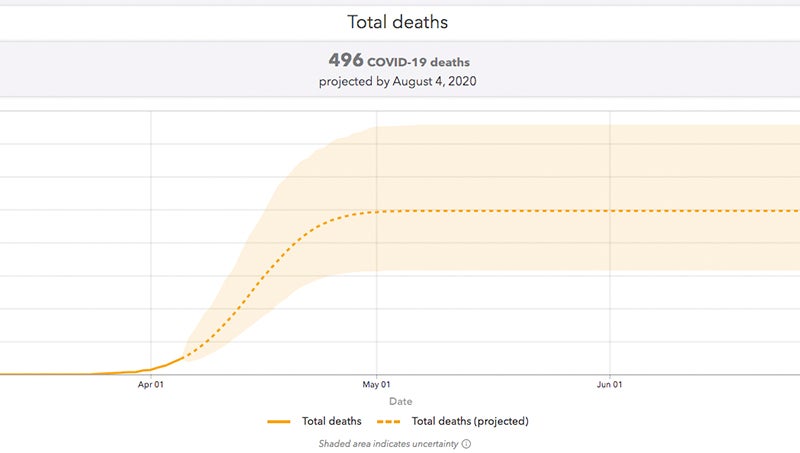COVID-19: Interventions necessary to keep county numbers down
Published 7:31 pm Tuesday, April 7, 2020

- ANALYSIS REVISED: The initial Institute for Health Metrics and Evaluation analysis, released in late March, projected up to 80 deaths per day in North Carolina at the peak of the COVID-19 virus. A new analysis, with an influx of data from hospitals across the country, has been revised to reflect new numbers, and a decrease of 2,000 deaths in North Carolina, as compared to the original number. (Institute for Health Metrics and Evaluation)
|
Getting your Trinity Audio player ready...
|
If Beaufort County residents were to make no effort to stop the spread of COVID-19, the end result could be between 200 and 600 hospitalizations and 15 to 22 deaths within the county — this was the message to Beaufort County Health Department Director Jim Madson had for Beaufort County commissioners Monday night.
Madson used a variety of data, including that of the worst flu season the county has seen in recent history: the flu season of 2017-18.
“The numbers I came up with would be the numbers if there was no mitigation occurring, so if we were just letting it run through our county like flu,” Madson said.
That’s why mitigation — social distancing, handwashing and now wearing masks, as recommended by the Centers for Disease Control and Prevention — is so important, he said.
“I’ve noticed quite a bit of it. I think there’s always room for improvement. People should take it serious as far as the interventions that we’re talking about. These interventions do have an impact on the rate of transmission in our county,” Madson said.
Madson said it will likely be next month before community transmission is less of a threat in Beaufort County.
“I think we’re still two weeks, maybe three weeks, away from peak, but we may stay in a peak state for a couple of weeks. So, I don’t see us getting to a recovery stage until somewhere in May,” Madson said.
REVISED PROJECTIONS
A massive infusion of data from across the U.S. has led to a revision of projected COVID-19 peaks by the Institute for Health Metrics and Evaluation. According to IMHE, North Carolina cases are now expected to peak on April 13; however, those numbers could be associated with the outbreaks in larger metropolitan areas, as opposed to rural North Carolina.
The independent global health research center based at the University of Washington’s School of Medicine issued new information after receiving an infusion of data from COVID-10 hotspots in New York, Massachusetts, Georgia, Colorado, Pennsylvania, Florida and California.
Where the initial projection was North Carolina could see as many as 80 deaths per day over the week of April 23 and a total of more than 2,500 deaths statewide, those numbers have been lowered across the board, to 496 deaths statewide and 30 deaths per day over the course of next week.
The data indicates efforts to stay at home and practice social distancing are paying off.
“As we obtain more data and more precise data, the forecasts we at IHME created have become more accurate,” said Dr. Christopher Murray, Director of IMHE. “And these projections are vital to health planners, policymakers and anyone else associated with caring for those affected by and infected with the coronavirus. … As we noted previously, the trajectory of the pandemic will change — and dramatically for the worse — if people ease up on social distancing or relax with other precautions. Our projections are
strengthened by the new downturns in more regions. This is evidence that social distancing is crucial. Our forecasts assume that social distancing remains in place until the end of May.”
IMHE, located in the first U.S. COVID-19 hotspot of Seattle, was initially asked to perform the ongoing COVID-19 analysis by the University of Washington School of Medicine and other U.S. hospital systems and state governments.
What its numbers have also found is that in treating COVID-19, patients who do not need admission into ICU are staying less time at hospitals, which has impacted the number of hospital beds available. However, for those who are admitted into ICU, the length of their hospital stays has increased.
IHME now forecasts 81,766 COVID-19-related deaths in the U.S., but that number comes with a possible range of 49,431 to 136,401.
“Our estimates assume statewide social distancing measures are continuing in states where they have already been enacted, and for those states without such measures in place, it is assumed they will be will be in place within seven days,” Murray said. “If social distancing measures are relaxed or not implemented, the US will see greater death tolls, the death peak will be later, the burden on hospitals will be much greater, and the economic costs will continue to grow.”




